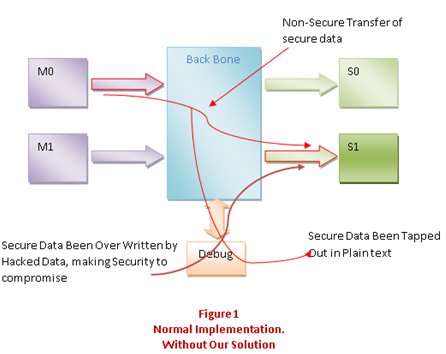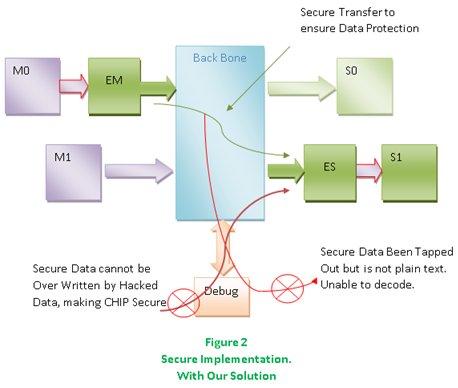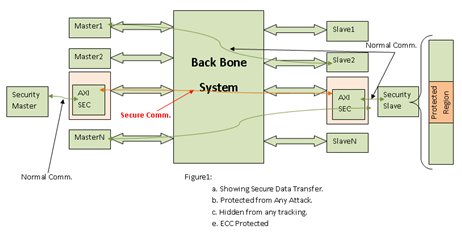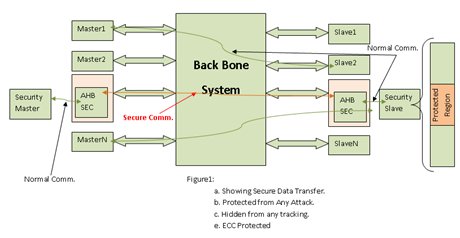Secure SOC for Security Aware Applications
By Rajesh Gupta, Green IP Core
Security is a two-way sword, increasing the security makes user difficult to access the chip and increasing user access increases chances for the chip to be hacked.
With the increase of need to make application secure and provide security to the content inside the chip from the external world and provide robust security from user to user ranging from developers at different stages to the user using the applications and hackers attacking the chips in different ways to gain access to internal secrets and firmware to duplicate the device or disturb the device functions.
The Solution for a secure system need to be complete in a way that it can provide easy ways for users to access the chip and ease to develop solutions and on the other side it need to be designed in a way that it hides secrets inside chip in a way that none of the user paths can access in any stage or the device be it at deployment stage to all the way to access stage to validate users, packets, signature or decrypt or encrypt the messages rolling around.
If the Secret key is rolling around, it can be accessed easily by implanting a bug in firmware or extracted out when it is being travelling on the internal bus system.
Access to enable debug is also gained by using Different attacks methods. Even if gained, it should have multi level security to block access to internal secrets.
A bug in the system software to enable any of such hack can be easily implanted by getting it through the user firmware update or installation path complied on same development environment which is provided by chipmaker or by just gaining access by enforcing bundles of request to block up the internal Security IPs sitting on the same backbone interfaces.


The SOC infrastructure we provide is one of its kind which isolates user access paths from the secure infrastructure implanted inside the chips be it from internal flash path or the external memory storing the encrypted secrets. Without putting a separate bus system. This also give options for Multilevel Security and Multilevel Access.
This infrastructure also blocks DPA and SPA analysis of Data. It is also resistant for Fault attacks and EMP Attacks.
It can detect event of Fault Attacks, EMP Attacks, Clock Glitch and Variations in Temperature and Voltage using Digital Methods and Enforce Security. Also, can Flag to system to take Immediate actions to enforce security.
The keys can be programmed once before the Boot using Secure Key Transfer Methods or Puff based Implementations. The Infrastructure is advance enough to understand a Hacking event verses a User Access Event. And can successfully block a hacker event even if accessed by a valid key.


These IP Blocks can be used to enable Hardware Security Level Isolations within a SOC without creating Separate Secure Infrastructure inside SOC.
One can use them to enable region based security by configuring these blocks with Master IDs, Session IDs, Region Access permissions over the secured channel.
These IPs are built with Resistance to tackle Harsh Hacking Environments and Take appropriate action to secure internal property of the device and the users.
For More Information, please contact us with your requirement at start@greenipcore.com
Related Semiconductor IP
- HBM4 PHY IP
- Ultra-Low-Power LPDDR3/LPDDR2/DDR3L Combo Subsystem
- HBM4 Controller IP
- IPSEC AES-256-GCM (Standalone IPsec)
- Parameterizable compact BCH codec
Related Articles
- How to Design Secure SoCs: Essential Security Features for Digital Designers
- Boosting RISC-V SoC performance for AI and ML applications
- SV-LLM: An Agentic Approach for SoC Security Verification using Large Language Models
- Secure Your Security Key in On-Chip SRAM: Techniques to avoid Data Remanance Attacks
Latest Articles
- Pipeline Stage Resolved Timing Characterization of FPGA and ASIC Implementations of a RISC V Processor
- Lyra: A Hardware-Accelerated RISC-V Verification Framework with Generative Model-Based Processor Fuzzing
- Leveraging FPGAs for Homomorphic Matrix-Vector Multiplication in Oblivious Message Retrieval
- Extending and Accelerating Inner Product Masking with Fault Detection via Instruction Set Extension
- ioPUF+: A PUF Based on I/O Pull-Up/Down Resistors for Secret Key Generation in IoT Nodes